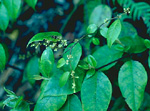 |
This small, tropical family is distributed from Malesia and eastern Australia to Polynesia. It is represented in Australia by one species, Trimenia moorei, which occurs in rainforests and wet sclerophyll forests in north-eastern New South Wales and south-eastern Queensland.
Characteristic features of the family Trimeniaceae in Australia include:
- woody climbers or scandent shrubs with rusty hairs on young stems
and leaves
- leaves opposite, simple, aromatic when crushed, finely dotted with
oil glands
- flowers small, whitish, in terminal or axillary panicles or branched
racemes, with usually 6 (if more then spirally-arranged) perianth segments
and 6–15 stamens
- ovary superior, usually 1-locular, with a sessile, tufted-feathery
stigma; fruit a small, 1-seeded fleshy berry
Description
Evergreen woody scrambling vines. Stem internodes ±terete. Internal secretions of essential oils. Plants with simple, non-glandular, unicellular hairs. Leaves opposite, petiolate. Stipules absent. Lamina simple, symmetric, elliptic or ovate; base cuneate, rounded or subcordate; margin entire or subcrenate; venation pinnate, with the midrib conspicuous, and the tertiary venation reticulate; surfaces punctate with dark gland-dots; herbaceous; distinctive odour aromatic. Male and female flowers occurring on the same plant or on separate plants, or with all the flowers bisexual. Inflorescences terminal or axillary, consisting of spikes or racemes. Bracts and bracteoles present. Pollination agent(s) unknown. Flowers sessile or stalked. Perianth regular, of one or apparently 2 whorls, with (2–) 6 (–11), free, ±petaloid segments, imbricate in bud, membranous, white or cream, without contrasting markings. Fertile stamens 6–15, with no clear relationship to the perianth, free from each other and from all other flower parts, ±equal. Anthers basifixed, not versatile; opening sideways or inwards by longitudinal slits, 2-celled; appendages apical. Ovary superior. Carpels 1 (–2), fused; ovary with 1 locule. Style absent and the stigma terminal and sessile on the ovary, tufted-papillose. Ovules 1 per locule; placentation apical. Fruit a fleshy, indehiscent berry; the perianth on the maturing fruit deciduous. Disseminule micro-surface ±smooth, mucilaginous, dark red to purple-black, ±glossy. Seeds 1 per fruit. Aril absent. Cotyledons 2. Embryo straight.
(Note: this description has been generated from the coded data compiled for the key. Any errors in the key data will be reflected in the descriptions.)
A treatment of the family Trimeniaceae has not yet been published in the Flora of Australia. It will appear in Volume 2.
Australian genera of Trimeniaceae (as recognised for the Flora of Australia)
Trimenia

|
  |

Trimenia moorei (flowers)
Photo: R.Bayer © R.Bayer
|
 |
|